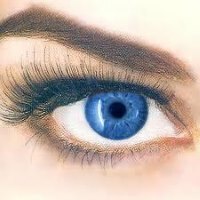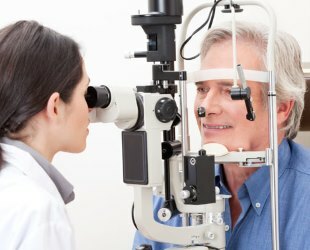
Diplomacy( so called in medical language double vision) is a symptom characterized by a lack of friendly eye movement, which is intended to provide a comparison of the image of objects.
As a result of diplopia, one item is perceived by the patient as two autonomous images.
In addition, dithering is often accompanied by dizziness, disturbed orientation in space, the distance can be incorrectly estimated.
Depending on the damaged muscle of the eye, diplopia is different: vertical, horizontal, diagonal.
Let us examine this symptom in more detail later in this article.
- 1. Description of symptom
- 2. Types of diplopia
- 3. Reasons for the appearance of
- 4. Diagnosis of diplopia
- 5. Treatment of
- disease 6. Prevention of diplopia
- 7. Exercises
- 8. Conclusion
Description of symptom
Eyes seeone and the same thing a little at different angles, but this difference to a healthy person is not noticeable. The brain processes the signals sent by the organs of vision and from two pictures forms one exact image. Under diplopia, a person sees both of these images at once, the brain does not subject anything to processing - this is the first and most important symptom of the disease.
The fact that the angle of view of each eye can be seen by closing one eye and looking at your finger relative to the background. Then, closing the other eye, you can see that the finger "moved" relative to objects in the background. Under diplopia, a person observes two images of the same object, not only horizontally but also vertically, as well as the cross turned upside-down.
Patients at risk are those who are injured or who suffer from such diseases, which can weaken the oculomotor muscles.
Types of Diplomacy
There are several types of diplopia and their classification according to classification:
- type;
- pathogenesis;
- etiology;
- development time;
- character of bifurcation.
Classification by etiology:
- Neuroparalytic diplopia. This is the result of neuromuscular diseases, such as multiple sclerosis.
- Okulogenic. It is associated with surgical intervention in the organ of vision.
- Orbital, has a traumatic origin. Strabogenic diplopia( accompanies strabismus).
Pathogenesis:
- Sensory. Such diplopia is associated with the limitation of the amplitude of fusions.
- Motor. Occurs when some of the muscles in the eye are affected. This is a frequent type of diplopia.
- Mixed.(Motor and sensory).
By the time of clinical manifestation, bifurcation is permanent and unstable. Non-permanent or temporary bifurcation of vision is a condition that can result from various traumas, a strong degree of alcoholic intoxication, as a result of side effects from the taking of certain medicines.
By the nature of bifurcation:
- Cross-diplopia or unliter. With this type of disease, the picture intended for the left eye is projected from the right side and vice versa.
- Cyclodeplopy. Refers to a complex form, occurs with severe motor and sensory disorders, accompanies strabismus.
- Binocular or the same name. Occurs when the visual axes are not parallel. It is not difficult to detect such a disorder, the patient is asked to tilt and turn his head in different directions, thus the eye deviation becomes noticeable. A patient with a similar visual impairment sees a bifurcated image that disappears if one eye is closed and has a restriction in the movement of the eye orbit.
Monocular view of bifurcated vision stands somewhat apart from the rest of the species, differs in that the double picture is preserved if the healthy eye is covered. Such an anomaly arises from ophthalmic or mental diseases.
There is also a concept like volitional diplopia, it is caused by a person consciously. For example, look afar through an object located at arm's length. Thus, you can see that this item is bifurcated.
Causes of the appearance of

The causes of bifurcation may be different for each type.
The causes of neuroparalytic diplopia lie in general neuromuscular diseases, such as:
- multiple sclerosis;
- myasthenia gravis;
- poliomyelitis;
and other similar diseases, in which all the muscles of the body weaken.
The causes of sensory diplopia are most often associated with the development of strabismus in children with a congenital fuzzy defect, and the disease may appear after successful strabismus surgery.
Motor diplopia develops as a result of:
- paralysis associated with brain trauma;
- paresis of extraocular muscles;
- of neurosurgical operations;
- vascular disease;
- of general infectious diseases, including toxic ones;
- of infectious pathologies in the eye cavities.
Rubella, tubercular meningitis, tetanus, diphtheria, vasculitis, among toxic ones - botulism, etc. can be distinguished from infectious diseases leading to the development of diplopia.
Pareases of extraocular muscles can arise as a consequence of such diseases: Moebius syndrome, Gref's disease and other CNS diseases.
Brain trauma can cause damage to the nerve or eye muscles. Also one of the reasons for this diplopia is endocrine myopathy, which develops against the background of hypothyroidism.
About the reasons for the emergence of temporary diplopia has already been said, we can add that the dichotomy of vision occurs with acute impairment of cerebral circulation, epilepsy. Eyeballs with an acute attack of such diseases deviate upward or to the sides.
Monocular diplopia, a rare type of pathology, is associated with such ophthalmic diseases:
- opacity of the cornea of the eye;
- lens opacity;
- iridodialysis;
- astigmatism;
- retinal tears;
- Palinopia
- psychoneurotic diseases.
Diagnosis of diplopia
Diagnosis of double vision in the eyes is carried out on the basis of complaints from patients by an ophthalmologist, which includes, in addition to a classical examination, an additional examination: computerized tomography of the head, ultrasound examination of eyeballs, etc.
The examination is conducted when the patient looks at the moving light source. The ophthalmologist determines the presence of the eye muscles and prescribes treatment.
If there are no abnormalities in the line of ophthalmology, the patient is referred to such specialists as endocrinologist, traumatologist, neurologist, oncologist, rheumatologist, infectious disease specialist to determine the cause of diplopia and prescribe the required treatment.

Note - the symptoms of Scleritis. How correctly to diagnose?
In the article( link), all reviews about the eye clinic of Helmholtz.
Price for Clonidine!http: //moezrenie.com/lechenie/ kapli-dlya-glaz / klonidin-sposob-primeneniya.html
Treatment of the disease

Diplomacy is a symptom that can not be ignored, it is mandatory to go to the clinic for a detailed examination and the appointment of appropriate medications.
Treatment of this disease is aimed at eliminating the causes that caused doubling. As mentioned earlier, the cause of diplopia is not always eye disease.
When doubling in the eyes in different directions( vertical, horizontal, diagonal), you can perform special exercises recommended by your doctor. Such exercises are most effective when developing partial diplopia, perform them 3 times a day.
If double vision is observed in the child, then in this case immediately it is necessary to consult an ophthalmologist.
There are several classic ways to treat diplopia.
- Prismatic correction - in this way the patient is shown wearing glasses with prisms that deflect rays and thus shift the image. A variant of prismatic correction are Fresnel prisms - these are thin overlays for ordinary glasses. The advantage of such lenses is that when they restore normal vision they are replaced by prisms with different refraction.
- Occlusion of .In this way, one eye is "turned off".In the case when several nerves are affected, this method is one of the most practical options for getting used to changes in vision. Occlusion leads to a loss of 3D perception, but this does not mean that the patient will have to wear a pirate dressing: modern ophthalmology has special contact lenses, and you can use a thin opaque tape on the lens of sunscreen or ordinary glasses.
- Injection of botulinum toxin .Such injections lead to temporary as well as permanent relief of the conditions of patients with symptoms of double vision. Botox is injected into one of the eye muscles under local anesthesia, which in most cases helps to achieve the desired result and prevents the development of contractures.
- Surgical intervention .In exceptional, most extreme cases, the possibility of surgical intervention to restore the symmetry of eye positions is considered. Such an operation is performed under general anesthesia and usually leads to a complete restoration of vision.
The described treatment is indicated only if the development of diplopia is associated with eye pathology, in the opposite case, the treatment consists in arresting the causes that caused the disease:
- treatment of stroke, neuropathy, neuralgia, etc.,
- treatment of infectious diseases with medications such asantibiotics, diuretics, anti-inflammatory drugs, etc.,
- treatment of volumetric processes in the orbit( removal of tumors, hematoma).

Read more - instructions for use on Clofelin. How to take the drug?
In the news( here) all the causes of yellow eyes.
Analogues of Acetazolamide!http: //moezrenie.com/lechenie/ kapli-dlya-glaz / atsetazolamid-pokazaniya-protivopokazaniya.html
Diplopia prophylaxis
This disease is characterized by unpredictability of its development, therefore it is inadvisable to carry out any preventive measures.
However, you can avoid doubling in the eyes if:
- permanently abandons bad habits( social harm - smoking, alcohol),
- lead a banal healthy and active lifestyle: it is recommended to conduct regular walks at least 2 hours, exercise,adhere to the regime of night and day,
- undergo a preventive examination by doctors,
- to monitor blood pressure.
Exercises
There are many exercises that are aimed at getting rid of or improving the condition of a patient with diplopia. It can be gymnastics directly for the eyes, for the muscles of the upper cervical spine, training of perception of normal binocular vision.
Gymnastics for normal blood circulation of the brain and organs of vision 5-10 times. Each exercise is done smoothly, but at the same time quickly:
- We look first to the right, then to the left, while turning our heads, not our eyes.
- We bend our head to the left until it touches the shoulder or is close to this position.
- We bend our head forward, then back, neatly, without tipping over.
- Perform rotational movements of the head in one and the other side.
- We make circular movements with shoulders with hands down.
- Again, circular movements with shoulders, but now on the shoulders you need to lower your hands.
Exercises for the eyes
Perform 5 to 20 times. Before each exercise, you need to blink a little:
- Preparation. Sit in a comfortable position, blink to relax your eyes.
- Look up, then down, pausing for a second in extreme positions, without moving your head.
- To translate a view to the right and to the left, also lingering in extreme positions.
- Drive your eyes on the diagonal line drawn in the air, it should turn out "cross-wise"
- Drive eyes clockwise, then against;
- "Draw" with the eyes the square clockwise, then against.
- Take the handle at arm's length, focus on it, bring the handle closer to touch with the nose, while continuing to look at it, slowly return to its original position. Then look at the distant object for 3 seconds.
- Close your eyes with force, then slowly open them.
Training binocular vision of patients with diplopia
Normally, looking at an elongated arm, objects remote from the hand or approximate, forked.
For the perception of normal physiological twitching without any pathologies, there are special exercises that need to be performed every day 5 times per 15 minutes.
1. A small object is placed 15 cm from the patient, for example, a vertical handle at the level of his eyes. Far away, through a meter 3-5 install any object, for example, a chair. It is necessary to look only at the chair. If the handle does not double, then close one eye, then the other eye with your hand.
Attention of the patient accentuate that the handle thus "moves" that to the left that to the right. The patient is explained that, since the handle is seen by each eye in different places, then having looked into the distance with two eyes, the handle should bifurcate.
Patient, alternating the overlap of the eyes and, looking at a chair in the distance with two eyes, should achieve a normal perception of the bifurcation of the handle. If it turns out, then do the second exercise or repeat until it turns out.
2. Now look at the handle. If the patient does not observe the double vision of a chair located at a distance, he must stretch out his hand and place the brush like a flap vertically after the handle and in front of the chair. He moves his hand in different directions from the handle, so that it coincides with the left edge of the palm, then with the right.
The patient is prompted that the chair also "moves" to the left or to the right, and therefore, when viewed with two eyes, the chair should bifurcate. Then the patient, alternately moving his wrist and removing, fixes his eyes on the handle, he must see the doubling of the chair. After a steady success, the third task is completed.
3. Colored pencils are attached to the bar about 1 meter long. Do this along the strip at a distance of 15 cm from each other, then the bar is set at the eye level of the patient parallel to its view( along), the pencils are located vertically.
The patient looks at the pencil near to him, slowly moves his gaze to the second one, etc., then in the reverse order. Only the pencil on which the patient is looking should be perceived, and it is necessary to see the bifurcation of the remaining pencils.
Eye Relaxation
This is an equally important part that helps fight and prevent eye pathologies. Relaxation of the eye muscles with the help of dark can be done at home or at work, it will take about 5 minutes.
- Sit comfortably at the table, resting your elbows on its surface.
- Rub hands against each other to feel the heat.
- Close your eyes to prevent light from passing through your fingers. In this case, the hands are superimposed on one another so that the fingers cross over, and tightly press against the face, but the eyes should not be pinched and free to rotate under the eyelids.
If you can not sit comfortably, with a flat back, you need to put soft objects of the desired height on the table. After a few minutes, slowly open your eyes and blink.
Conclusion
When bifurcation in the eyes, you should always consult an ophthalmologist for advice. It should be remembered that diplopia can occur for a variety of reasons;in time to understand and eliminate them means to save themselves from adverse consequences.
In order not to face such a disease it is necessary to monitor the state of health, to treat infectious and other diseases in time. If most of the time is spent sitting at a computer or work requires constant attention, then you need to regularly perform exercises for the eyes.
